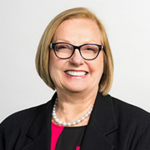
Jul 24, 2020
See What Nurses See
To address population health during the pandemic, we must support and expand nurses’ abilities to assess and address social factors impacting health.
During these trying times, I often think of the faces of my nurse colleagues. Though they wear masks, you can see in the eyes of nurses the impact of experiencing case after case of the same harrowing disease all day, often in longer shifts that they have worked in their entire lives.
In some of those eyes, you can see the impact of losing patients. In others, you can see the fear of how to talk to yet another family over video chat. In all of them, you can see the anxiety over adapting their nursing practice to this new reality. In a real sense, nurses and other healthcare workers are facing this disease on behalf of everyone. What have they seen that no one else sees? What could they look for that no one else can?
In Population Health and the Future of Nursing: Conclusions, published earlier this year, we argued that assessment is the most important area where nurses can immediately address health disparities. We laid out a plan, beginning on page 8 of the report, to help all nurses more effectively address health equity using assessment as a common starting point. While some social needs have changed due to the COVID-19 pandemic, we believe that addressing population health starts with seeing what nurses see.
The pandemic has made assessment even more important as a way for nurses to make sense of their reality. With more than 3 million cases spread over 50 states, all practicing nurses are thinking about what it means for COVID-19 patients to present themselves in their hospitals, clinics, and offices. Many nurses are facing the disease in their homes and communities as they provide advice to neighbors and family about self-isolation or contract tracing. In the months to come, nurses in every setting will gain familiarity with the biological traits of this disease.
But as the emerging data make clear, nurses also need to be aware of the social factors that impact the COVID-19 patient experience and the national response to it. In our research, we learned that many different organizations were already relying on nurses to assess and address the social needs of patients. Therefore, we believe that this is also a natural area where nurses can lead during this crisis.
Many of the social needs assessment practices we observed in our work were preliminary; nurses and others were still working to discover the best way to talk about complicated issues like racism and poverty. As we respond to this pandemic, they will not be able to be so deliberate. Every kind of social issue will be showing up in the bodies of COVID-19 patients who do not have time for testing new approaches.
Nurses will rapidly need to assess how a person’s background, past health issues, and circumstances affect their treatment and recovery. Patients who have lacked access to care over their entire lives may not be prepared to alert clinicians to underlying problems like asthma or diabetes. Many will reject the idea of staying at home if they are a family’s sole provider; others may not be sure they have a home to stay in at all.
As new outbreaks occur, health care providers must understand how to adapt COVID-19 containment and treatment in response to all these issues. We maintain that an adequate response begins with assessment, and assessment will almost always begin with a nurse.
Despite extraordinary circumstances, nurses still desire to perform assessment in a way that reflects our profession’s best traditions and values. These include seeing the patient as a whole person, providing advice to get that specific person adequate care, and performing health education and advocacy appropriate to the situation.
But as a profession, we must also think more critically about how we realize these values in the midst of a pandemic. In our original report, Nursing Education and the Path to Population Health, we laid out a plan, beginning on page 4, for the nursing profession to take responsibility for the assessment of social factors in health care. We believe an updated version of the same plan could be implemented now with a focus on the nurses on the frontlines of this pandemic. Key to the plan is the idea that we must recognize and even expand nurses’ authority to assess and address the social challenges patients face.
Our institutions should immediately do everything they can to support the nurse who is not only diagnosing COVID-19, but also considering how to address a patient’s homelessness or how to adapt stay-at-home protocols for a family where both parents work the night shift.
This support should begin with simply acknowledging the complex situations nurses face. But we hope that over time it can become the basis for the development of best practices, new research into how to best identify and address social factors, and policy advocacy that makes it impossible for decision-makers to deny what nurses are seeing every day.
In the weeks to come, we will explore what the pandemic means for other elements of our plan for population health in nursing, such as the use of data and academic-practice partnerships. But all of our other recommendations depend on centering this assessment experience that is so essential to what it means to be a nurse.
It’s time to acknowledge what nurses see and give them tools to do more to respond.
 Patricia A, Polansky, RN, MS, is the director of Program Development and Implementation at the Center to Champion Nursing in America.
Patricia A, Polansky, RN, MS, is the director of Program Development and Implementation at the Center to Champion Nursing in America.
